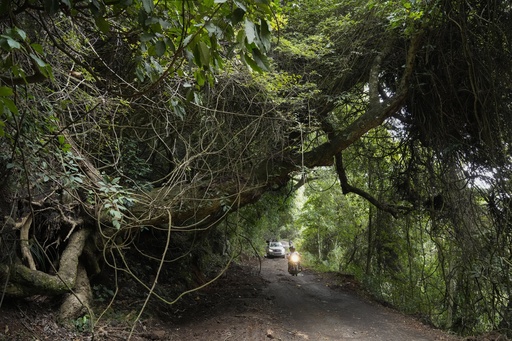
UDHAGAMANDALAM, India — In the Nilgiris region of southern India, a unique ecosystem exists where native trees, flowers, and ancient burial sites share space with expansive tea plantations. This area serves as a remnant of the landscape before the advent of colonization and the widespread commercial cultivation of tea, which drastically altered the mountain terrains.
Once flourishing with dense foliage, these sacred groves, which play an important role in local traditions, have significantly diminished over the last two centuries. The introduction of British colonial tea plantations transformed much of this land. The remaining groves are either safeguarded by Indigenous communities preserving their cultural heritage or are being rejuvenated by ecologists who work tirelessly to reclaim lands currently dominated by tea. They focus on removing abandoned tea trees and planting seeds native to this high-biodiversity zone. Their dedication is beginning to yield positive results as new forests develop in response to their restoration efforts, despite the ongoing challenges posed by ecological damage and the erratic weather conditions driven by climate change.
The teams engaged in forest restoration are acutely aware of the need to coexist with the local community, comprising more than 700,000 residents who are primarily involved in tea farming or catering to roughly 3 million tourists visiting to escape the intense heat of the plains. Local naturalist Godwin Vasanth Bosco emphasized the importance of ecological restoration in today’s climate crisis. “What we’re trying to do is to help nature restore itself,” he stated.
Industrial-scale tea cultivation has been linked to nutrient depletion in soils and increased human-wildlife conflict, especially with species such as elephants and gaur, which are now seeking refuge in smaller forest patches. Reports estimate that nearly 135,000 acres of tea have been cultivated, severely impacting 70% of the region’s native grasslands and forests.
The tea plantations are noted to lack biodiversity, making them unsuitable habitats for local wildlife. Gokul Halan, a water expert from Nilgiris, pointed out that these monocultures do not support local fauna and fail to provide essential food sources. While the forests within this tea landscape are recognized by the United Nations as one of the world’s paramount biodiversity hotspots, the areas suffering from overuse of pesticides and other farming practices are often regarded as “green deserts” due to their poor soil quality and inability to sustain diverse life forms. Additionally, the region faces pressure from urbanization to accommodate the growing tourist population, further straining environmental health.
The deterioration of land elevates the risk of landslides and floods, an issue worsened by climate change, as highlighted by the devastating landslides in the nearby Wayanad region earlier this year that resulted in significant loss of life. Halan has cautioned that Nilgiris could face similar disasters if swift action is not taken, particularly noting the rising incidence of droughts and extreme heat that have started to impact tea yields.
There is hope for life to return to the Nilgiris. In areas where restoration efforts have taken root, such as a small mountain fold below the highest peak, native trees planted a decade ago now reach heights of 4.5 meters (15 feet), and a stream that was once dry has started flowing year-round following the removal of tea plants over several acres.
Bosco describes this ecological transformation, noting that these Shola-grassland forests, known for their capacity to capture moisture from high-altitude mist, have a profound ability to foster life across the 2,000 acres under restoration by his organization. The native trees enrich the soil, enabling saplings and other small plants to grow, even in the arid conditions seen in summer.
This area is also home to Indigenous communities, known as Adivasi, some of whom are classified as highly vulnerable due to dwindling population numbers. Community representatives argue that they are the original guardians of these forests and have also been active in reforestation efforts. Adivasi member Mani Raman lamented the loss of land and culture following the establishment of tea estates by the British, voicing hope for restoration as a means to revive wildlife populations.
Conversely, tea farmers and factory operators voice concern over the economic implications of converting tea fields back to forests. They assert that the region’s economic framework is heavily reliant on tea production, which they argue is less harmful to the environment than unchecked tourism development. A Balakrishnan, an owner of a local tea factory, asserted that transitioning away from tea would negatively affect both the economy and the ecological landscape of Nilgiris.
Bhojan, a lifelong tea grower, echoed this sentiment, estimating that tea farming supports about 600,000 individuals, including thousands of small-scale farmers, underscoring the essential role tea plays in the community. Balakrishnan added that maintaining tea plantations provides economic advantages over restoring native forests.
To find a balance, experts propose agroforestry, incorporating native trees and shrubs in tea farms, enhancing biodiversity within the tea landscape. Halan suggests this approach could create a more sustainable environment, leading to a less hostile coexistence between agricultural practices and ecological restoration.
Government support has also emerged as officials in Tamil Nadu announced a $24 million investment into transitioning farmers toward eco-friendly practices. Plans to plant nearly 60,000 native trees throughout the region were also revealed.
Bosco stressed that cultivating unique, high-quality tea could allow farmers to benefit economically while also enabling areas for reforestation. He proposed that if local restoration efforts were recognized and compensated, they could provide another income stream for residents through new products derived from native plants.
Raman believes that lessons can be drawn from the traditional practices of Adivasi in protecting forests, urging state authorities to employ these methods on a larger scale. “Wherever we live the forests are protected,” he said, advocating for a more systematic approach to conserving this vibrant ecosystem.
